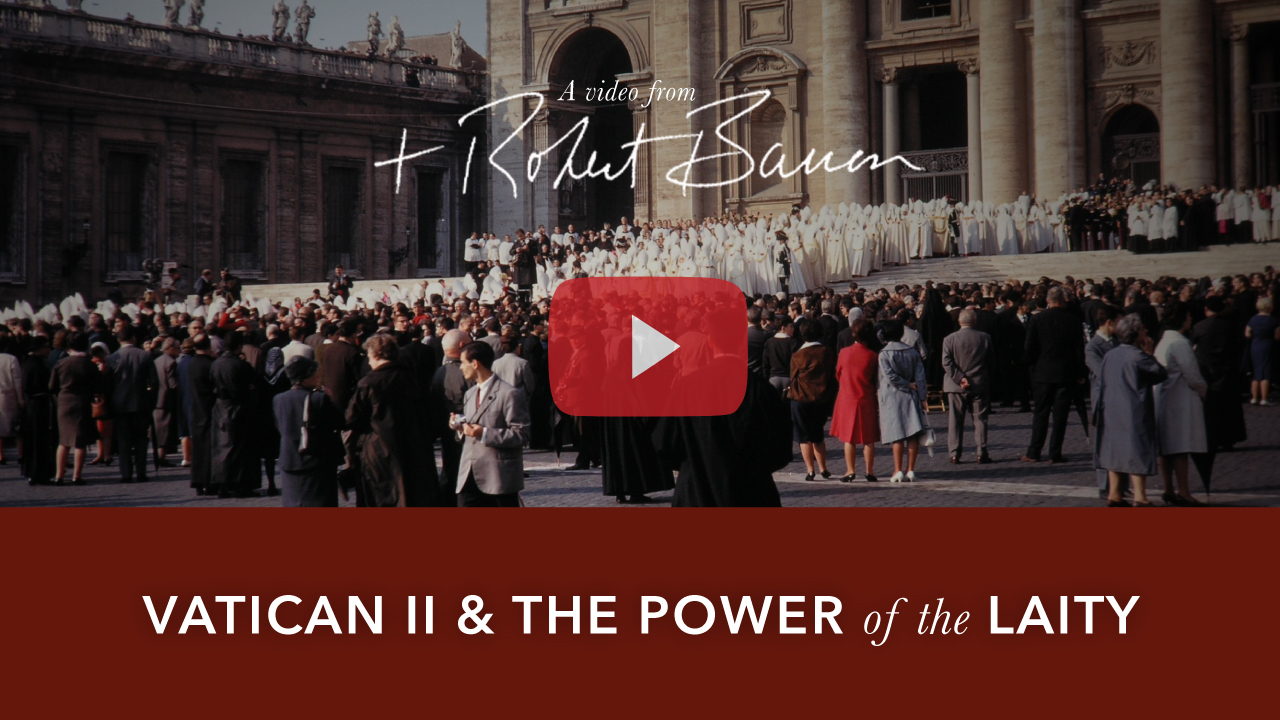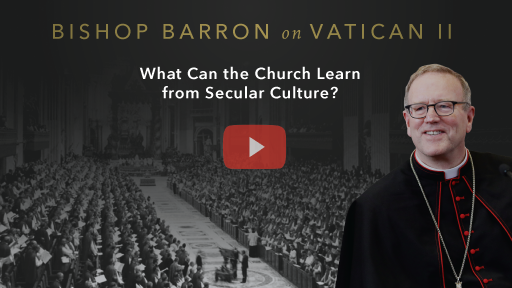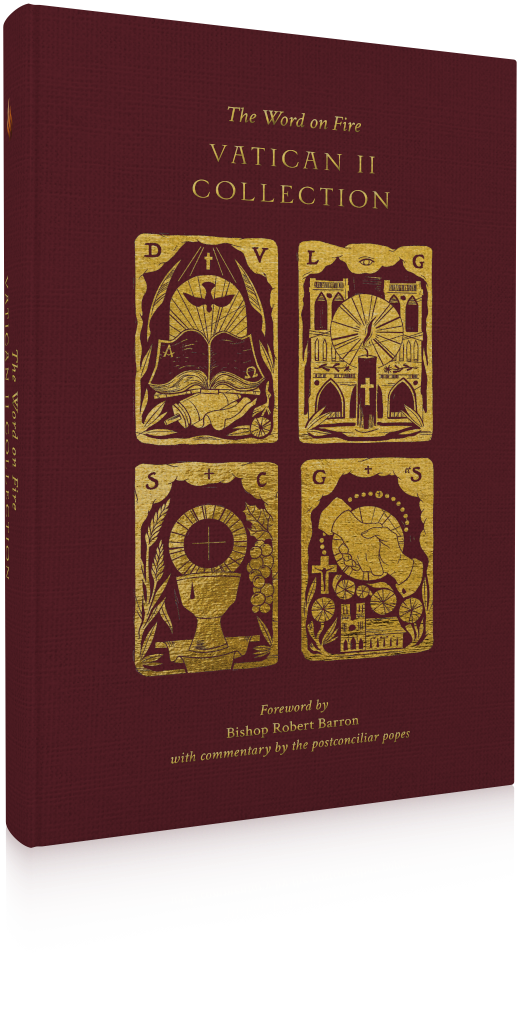ABOUT the BOOK
The Second Vatican Council (1962–1965), a gathering of Catholic bishops from around the world, was one of the most significant cultural and religious events of the twentieth century. Though practically everyone acknowledges its importance, Catholics have been debating its precise meaning and application for the past sixty years. On the one hand are “radical traditionalists” who claim that Vatican II betrayed authentic Catholicism and produced disastrous consequences in the life of the Church; on the other, “progressives” who saw the council documents as a first step toward more substantial changes in the Church.
But even as debate over the council rages on, not enough Catholics have actually read or properly understood its texts. This groundbreaking new book from Word on Fire is designed to address that problem.
The Word on Fire Vatican II Collection, an elegant hardcover volume with beautifully carved linocut art, features the four central documents that most fully articulate the vision of the council—Dei Verbum, Lumen Gentium, Sacrosanctum Concilium, and Gaudium et Spes. In the style of The Word on Fire Bible, it also includes illuminating commentary from the postconciliar popes and Bishop Robert Barron interspersed throughout, so that readers will understand how the Church authoritatively interprets different passages.
The collection also includes the opening address of Pope St. John XXIII, the closing address of Pope St. Paul VI, a foreword from Bishop Barron, an afterword from theologian Matthew Levering, and helpful appendices listing key terms, figures, and answers to frequently asked questions. The Word on Fire Vatican II Collection is a robust and readable journey into the true history and purpose of the Second Vatican Council, and a compelling call for an enthusiastic return to its texts today.
Publisher: Word on Fire Institute
Release Date: March 18, 2021
Format: Hardcover (cloth)
Pages: 392 pages
BISHOP BARRON on VATICAN II
BISHOP BARRON
on
VATICAN II


















VATICAN II FAQs
Vatican II, or the Second Vatican Council, was the twenty-first (and most recent) ecumenical council of the Catholic Church. Ecumenical councils, which go back to the Council of Nicaea in 325, are gatherings of bishops from around the world, under the leadership of the pope, to authoritatively discuss and define Church doctrine and discipline.
An ecumenical council is an extremely rare occurrence, a “solemn” exercise of episcopal power (CCC 884). It is the highest ranked and most important of seven types of general councils possible in the life of the Catholic Church.
Vatican II was opened under Pope St. John XXIII on October 11, 1962, and closed under Pope St. Paul VI on December 8, 1965. The Council culminated in sixteen documents promulgated by Pope St. Paul VI, including four central “constitutions”:
- Dei Verbum (Dogmatic Constitution on Divine Revelation)
- Lumen Gentium (Dogmatic Constitution on the Church)
- Sacrosanctum Concilium (Constitution on the Sacred Liturgy)
- Gaudium et Spes (Pastoral Constitution on the Church in the Modern World)
These documents—not a nebulous “spirit of Vatican II” that misrepresents or misapplies them, or a narrow “traditionalism” that reacts by rejecting them—are the soul of Vatican II.
No. Unlike many other ecumenical councils, Vatican II did not in an extraordinary way define any new dogmas of the Church or condemn any heresies.
But it is not unique in this respect. In fact, three ecumenical councils—the First Lateran Council (1123), the Second Lateran Council (1139), and the Third Lateran Council (1179)—were disciplinary councils. Not only did these ecumenical councils not define any new dogmas, they did not address matters of doctrine at all.
No. While the Council did not define any new dogmas (see question 2), and while its aims were largely pastoral, Vatican II also reaffirmed dogmas of the faith and developed key doctrines. In other words, the Council’s substance—as the names of its four constitutions make clear (see question 1)—are not merely dealing with pastoral matters.
This is a false dilemma. First, as stated in question 3, Vatican II does affirm infallible dogmas of the faith. These affirmations require the assent of faith on the part of Catholics.
But even when they are not affirming infallible dogma, the Second Vatican Council presents the teachings of the ordinary and universal Magisterium through an ecumenical council of the Church. This means that these teachings are assisted by the Holy Spirit (CCC 688), are promulgated by the pope in communion with the “authentic teachers of the apostolic faith endowed with the authority of Christ” (CCC 888), and require “religious assent which, though distinct from the assent of faith, is nonetheless an extension of it” (CCC 892). In short, the teachings are guarded from doctrinal error and are binding on all Catholics; they are not optional.
On January 12, 1966, Pope St. Paul VI said in an audience: “Given the Council’s pastoral character, it avoided pronouncing, in an extraordinary manner, dogmas endowed with the note of infallibility.” This quote has often been used to suggest the Council's teachings and decrees are not binding on Catholics.
However, as Dr. Jeff Mirus has explained, all this is really saying is what is described in the previous three questions: that Vatican II, while largely pastoral in nature, did not in an extraordinary way (i.e., invoking infallibility) define any new dogmas. Pope Paul VI was not saying that Vatican II is merely pastoral, subject to doctrinal error, or not binding.
On the contrary, in the very next sentence he adds, “But it [the Council] has invested its teachings with the authority of the supreme ordinary magisterium, which ordinary magisterium is so obviously authentic that it must be accepted with docility and sincerity by all the faithful, according to the mind of the Council as expressed in the nature and aims of the individual documents.”
No. In light of questions 1–5, this is not a valid option for Catholics. To ignore, disparage, or reject Vatican II is to call into question the living teaching authority of the Church itself, which was given by Christ (CCC 874) and is accomplished in the Holy Spirit (CCC 78). It is to place oneself in a dangerous spiritual attitude with respect to “the fullness of the means of salvation” (CCC 824)—the one, holy, Catholic, and apostolic Church—by setting oneself above its Magisterium as judge.
Pope St. Pius X warned against this attitude in 1909:
“Do not allow yourselves to be deceived by the cunning statements of those who persistently claim to wish to be with the Church, to love the Church, to fight so that people do not leave Her . . . but judge them by their works. If they despise the shepherds of the Church and even the Pope, if they attempt all means of evading their authority in order to elude their directives and judgments . . . then about which Church do these men mean to speak? Certainly not about that established on the foundations of the apostles and prophets, with Christ Jesus himself as the cornerstone.”
No. It has been suggested that this could happen to Vatican II in light of two errors in past councils that were later corrected: one attributed to the Council of Constance, and one to the Council of Florence.
But as distinguished historian Cardinal Walter Brandmüller pointed out, neither of these cases is analogous to reversing doctrine from Vatican II. In the case of Constance, the decrees in question were issued earlier by a schismatic assembly that had no authority—only later on did the gathering become a true ecumenical council, so none of its earlier decisions were authoritative or binding. In the case of Florence, the reversal did not have to do with doctrine at all—only a disciplinary matter.
The doctrine articulated by Vatican II is, under the guidance of the Holy Spirit, part of the Catholic Church’s official magisterial teaching. It may be deepened or clarified in the future, but it cannot be removed or reversed.
These terms originate in an address given by Pope Benedict XVI in 2005. In that speech, he contrasts two “hermeneutics,” or ways of interpreting, Vatican II. On the one hand is “the hermeneutic of discontinuity or rupture,” the idea that Vatican II is a split or break with Catholic tradition. On the other hand is “the hermeneutic of reform,” or continuity, the idea that Vatican II is consistent with Catholic tradition.
Both those on the extreme “left” and the extreme “right” have interpreted Vatican II as a rupture—a good rupture and a bad rupture, respectively.
But Pope Benedict XVI championed the hermeneutic of continuity, saying: “The Church, both before and after the Council, was and is the same Church, one, holy, catholic and apostolic, journeying on through time.” Vatican II was not a break or rupture; it must be interpreted in continuity with the tradition that came before.
This position has also been defended more recently by Cardinal Robert Sarah. In his book The Day Is Now Far Spent, he argues:
“The hermeneutic of reform in continuity that Benedict XVI taught so clearly is an indispensable condition of unity. Those who make sensational announcements of change and rupture are false prophets. They do not seek the good of the flock. They are mercenaries who have been smuggled into the sheepfold. Our unity will be forged around the truth of Catholic doctrine. There are no other means.”
Theologian Edward Schillebeeckx has been quoted as saying, “We have used ambiguous phrases during the Council and we know how we will interpret them afterwards.” The suggestion is that conspirators planted certain phrases within the Vatican II documents that appeared vague and innocent on the surface, but would later be exploited by those wishing to overturn traditional Church teaching.
However, this quotation is not found in Schillebeeckx's own writings but in a book titled Open Letter to Confused Catholics, written years after the Council by Archbishop Marcel Lefebvre. Lefebvre was an ardent critic of Vatican II who founded the once schismatic and still canonically irregular SSPX society. In the book, Archbishop Lefebvre shares the quote apparently from memory, without any source or citation, and adds, “Fr. Schillebeeckx admitted it. . . . Those people knew what they were doing.” The source casts serious doubt on the truth of this quotation, which is not corroborated anywhere else, and thus offers no support for the idea that those who influenced Vatican II deliberately used (“weaponized”) ambiguity to distort Church teaching. There is simply no evidence of such a conspiracy.
(It's also worth noting that Fr. Schillebeeckx was not a bishop and thus had no vote about the language used in the final Vatican II texts.)
Absent any reliable evidence to the contrary, Ven. Fulton Sheen’s assessment in his autobiography seems far more trustworthy and reasonable:
“Those who read the Documents of Vatican Council II have no idea how much care and preparation went into every word they contained. . . . I can testify to how we would discuss various Latin words for a day in order to arrive at a precise meaning. Then, after a chapter was prepared, printed, and given to the Council Fathers, the debates on each subject went on for months until finally there were hammered out documents that were acceptable to all except a very few who voted against them.”
Finally, it’s worth adding that sometimes, including in the Councils of Trent and Nicaea, theologians are not in full agreement and so somewhat ambiguous statements must be used in the final documents. For example, at Nicaea the term homoousios is applied to the Son but not to the Spirit—and this was done to placate a minority of disagreeing bishops. That ambiguity could later be exploited unfaithfully, but it could equally be developed faithfully under the guidance of the Holy Spirit by later councils—which is indeed what happened.
As another example, the Council of Trent did not resolve various theological disputes about the Eucharist between Jesuits, Dominicans, and others. The language used is ambiguous enough to allow for diverse theological opinions.
The key point is this: all councils employ some theological language that is inevitably ambiguous in certain ways. It may be that there are theologians present at a council—contributors to a conciliar text—that hope to employ the ambiguous language in a wrong way later. But the Church has a guardrail against this—namely, the Holy Spirit, who guides the Church in interpreting its councils and handing on the faith. The Catechism of the Catholic Church is an example of the Church rightly interpreting the Council’s words, and there are many other examples as well.
No. Sacrosanctum Concilium, the Constitution on the Sacred Liturgy, did not forbid any of these things.
On the contrary, it preserved Latin as the official language of the Latin rite, and had this to say of the use of Latin in the Mass: “Steps should be taken so that the faithful may also be able to say or to sing together in Latin those parts of the Ordinary of the Mass which pertain to them.”
Regarding Gregorian Chant, it said: “The Church acknowledges Gregorian chant as specially suited to the Roman liturgy: therefore, other things being equal, it should be given pride of place in liturgical services.”
Regarding pipe organs, it said: “In the Latin Church the pipe organ is to be held in high esteem, for it is the traditional musical instrument which adds a wonderful splendor to the Church's ceremonies and powerfully lifts up man’s mind to God and to higher things.”
It said nothing about liturgical orientation—that is, whether the priest celebrates the Mass ad orientem (facing the altar) or versus populum (facing the people). In fact, many churches have incorporated ad orientem worship into the Ordinary Form of the Mass.
Disagreements about these issues and more are due to the misimplementation of the Second Vatican Council texts, not the texts themselves.
No. The same Magisterium that gave us the ecumenical council of Vatican II has also allowed for continued celebration of the Latin Mass under certain conditions. To be a Catholic who reveres the Church's tradition, which is a living tradition, is to accept both the Extraordinary Form and the Ordinary Form of the Mass as valid.
No. It is important to note, first of all, that Catholicism is a global Church, and this erosion is a largely Western phenomenon. As the World Christian Database confirms, Catholic Church membership has significantly increased since Vatican II, with the most dramatic growth in Africa. (In fact, the only place where the Church has not been growing since Vatican II is in Europe.) It is projected that, by 2050, the largest percentage of Catholics will be in Africa:

Why has this moral and spiritual erosion occurred in our Western context?
There are two points to keep in mind, both of which were pointed out by Ven. Fulton Sheen: first, that the spirit of the age is what has eroded the faith of so many Catholics; and second, that turbulence is to be expected in the wake of any council.
In 1970, William F. Buckley asked Sheen if the drop-off in church-going and overall erosion of faith was caused by the zeitgeist, or by the ecumenism of the Second Vatican Council. Sheen responded: “No, I should not say that ecumenism was the cause of the erosion. Certainly, the zeitgeist is partly the cause—and very much the cause.” (The statistics showing an erosion in faith across Christian denominations, and indeed across religions, is evidence that Sheen was right.) It is also important to reiterate (see introduction, and question 1) that Vatican II is distinct from “the spirit of Vatican II.” The latter was often invoked to distort the Council according to the zeitgeist—often with disastrous results.
Later, Buckley challenges Sheen: If Vatican II was a missionary council, why is this erosion still happening around us? Sheen responds, with great humility and wisdom: “It’s going to take a long time for the yeast to work through the dough.” In fact, Sheen pointed out in his autobiography, Treasure in Clay, that a period of turbulence is to be expected in the wake of any ecumenical council. He writes:
“The tensions which developed after the Council are not surprising to those who know the whole history of the Church. It is a historical fact that whenever there is an outpouring of the Holy Spirit as in a General Council of the Church, there is always an extra show of force by the anti-Spirit or the demonic. Even at the beginning, immediately after Pentecost and the descent of the Spirit upon the Apostles, there began a persecution and the murder of Stephen. If a General Council did not provoke the spirit of turbulence, one might almost doubt the operation of the Third Person of the Trinity over the Assembly.”
We are all living through this time of great turbulence. But our hope is in the Holy Spirit, working through Sacred Scripture, Tradition, and the Magisterium, to renew the Church and use it to proclaim Christ to the modern world—but on God’s time, and in God’s way, rather than our own.



